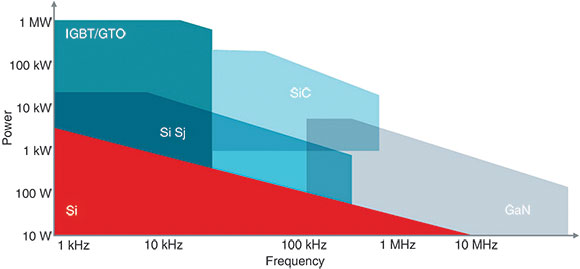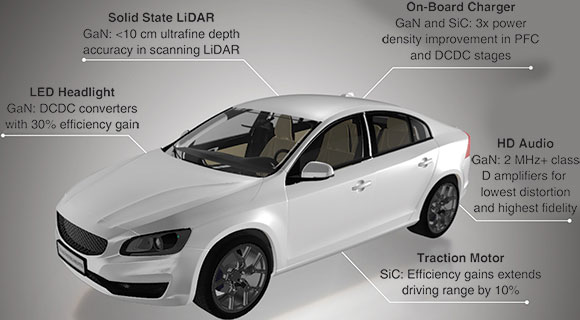
You may not know it, but the number of semiconductor chips per person can easily cover a small wall. These chips are used in a wide variety of applications from consumer electronics, devices for the Internet of Things (IoT), along with automotive and industrial machinery.
In fact, according to World Semiconductor Trade Statistics, each person on the planet purchased an average of 111 chips or integrated circuits (ICs) in 2016. The use of these semiconductor devices is growing at five times the human population growth rate. Soon the wall you can fill with your share of chips out there will no longer be so small.
This mushrooming expansion of semiconductor applications brings with it a similar growth in demand for operating power. But costs and the need to cut greenhouse gas emissions dictate that the ICs do more work using less power. These contradictory requirements confront all devices, but none more than those that convert line or battery voltage to voltages that the other chips in the system can use – the power supplies.
The growing need to use energy more efficiently has driven a continued evolution in silicon-based technologies, as well as in the development of technologies using new wide-bandgap materials, such as gallium-nitride (GaN) and silicon-carbide (SiC). Devices using these new materials offer greater power and size efficiency and are beginning to penetrate the power supply market.
As a result of these developments, today’s power systems designers have an increased range of power technology options – a necessity given the diversity of today’s electronic systems. It is not surprising that these technologies have varying strengths in different areas of the overall application space. To select an optimum solution, a power supply system designer must understand the trade-offs in efficiency and operating characteristics of the different options.
Different trade-offs in efficiency
Once, when there seemed to be energy to burn, linear power supplies did exactly that by dissipating unused power in the form of heat. Now, with energy costs rising and the climate at risk, priorities have changed. Efficient power utilisation has grown increasingly important for manufacturers and users.
In addition to power efficiency, there are other criteria that matter when it comes to selecting power supply solutions. For many systems, space is at a premium. Components must be smaller and heat minimised to reduce cooling requirements.
Power density, measured as watts per cubic centimetre (W/cm³) or watts per cubic inch (W/in³), is an important metric for the efficient use of space in all systems, but especially in those that are highly populated, such as data centres and telecom switches.
In other equipment, such as vehicles and portable electronics, space efficiency is coupled with the requirement for light weight. Power weight density, measured as kilowatts per kilogram (kW/kg), is another form of efficiency used to make design trade-offs for these systems.
Besides the need for power and space efficiency, along with weight, is cost. Every system design must meet a cost budget. In some cases, cost may even force compromises on power efficiency, space and weight if the best-rated options are not affordable. Quality and reliability are also crucial, as it is very costly to replace semiconductor devices and end equipment failing in the field.
The objective of power semiconductor development is to drive these efficiencies as high as possible, or in other words, drive power loss, space, weight, cost and failure rates toward zero. Power semiconductors that offer the best design trade-offs for one application area may not be optimal for another. This means that several types of power technologies are necessary, and equipment designers must carefully select the appropriate technology based on the requirements for their application.
Trends in power conversion improvement
Moore’s Law, the gold standard for years for digital CMOS and memory scaling, does not typically apply to power semiconductors. Digital circuitry voltages have fallen from 5 V to less than 1 V, increasing switching speeds and driving smaller lithography. Power supplies also have to process increasing levels of power to keeps input voltages high.
Another consideration is the design of power and other analog components, which is more multidimensional than digital chip design, where the effort is to repeat transistors with the same characteristics billions of times. New power transistor developments require that the electronic ‘ecosystem’ be retrofitted as shown in Figure 1, including control circuitry, packaging, thermal characteristics, protection from voltage transients, various forms of signal interference and magnetics. These environmental issues have to be addressed, and can sometimes involve considerable development across several areas for power transistors to advance to the next level of performance.

Despite the challenges, advancements in power ICs have been notable over time. For at least two decades, power losses have been cut in half every five years. Power supply modules have doubled in density every 10 years since the 1970s in space-critical applications like telecom.
Power technology issues in switching
The transition to switched mode power supplies (SMPS) is one important contributor to the rise in power efficiency. SMPS control voltage in the time domain through high-frequency pulse-width modulated (PWM) switching. SMPS can also double power efficiency over linear power supplies. However, they do bring new issues in the form of a higher bill of materials and greater design complexity. These factors become increasingly important as technology pushes towards higher power ratings and higher switching frequencies.
Because the industry has an established manufacturing base and expertise, silicon (Si) remains the least expensive power semiconductor material. Device innovations like the gate-controlled thyristor, insulated gate bipolar transistor (IGBT) and SuperJunction MOSFET have helped drive increased wattage ratings for power devices. However, Si devices cannot process large amounts of power while simultaneously switching very fast. This makes them less efficient in power conversion efficiency, as well as more heavy and bulky.
With increased use of GaN and SiC, the landscape for power systems is changing. The wider bandgap of these materials can enable devices capable of supporting higher voltages and high switching frequencies to permit the use of smaller passives. GaN and SiC power devices enable power systems that are more efficient, smaller and lighter than Si-based systems.
While GaN and SiC outrun Si, there are differences in performance to also consider. GaN operates at higher frequencies, while SiC handles greater input voltages and drives higher-power outputs (though appropriate power stage designs can enable GaN to achieve significantly high-power output). At this time, GaN tends to be the preferred choice for power supplies up to the 600 V to 700 V range in applications such as telecom and servers. In areas such as electric and hybrid vehicles and solar inverters, where higher voltage is required, SiC becomes a more suitable option.
Figure 2 shows the different power technologies and position relative to power levels and frequency. It should be noted, however, that while the areas shown are approximately correct, continued technology development will increase their range of support. Also note that there is a lot of overlap among these competing technologies, and no single power transistor type is a price-performance hands-down winner in every situation.

Solutions for the power ecosystem
While the overall market for power devices will demand all options mentioned in this article, GaN and SiC will drive the future of high power, density and weight efficiency. As the technologies become more mature and more offerings emerge, GaN and SiC will become more cost competitive with silicon, elevating their importance when evaluating design trade-offs. Thorough characterisation, physical understanding and continuous improvement in the reliability of wide-bandgap semiconductor devices will also be critical to help foster adoption.
Because GaN and SiC deliver higher switching frequencies, this can create some design challenges that can be dealt with successfully. These potential problems include high-frequency feedback from the switch onto the power line; high-frequency switching interference; timing issues that arise from narrow switching windows; and the increased criticality of any parasitic inductances in the switching path.
TI offers modules today that provide verified, ready-made solutions to address these challenges and significantly reduce development time and anxiety from system designers who may shy away from what is perceived as the overly complex nature of designing with wide-bandgap technologies.
Advanced application areas
Power supplies are a crucial part of all electronic systems, from handheld novelty products to large industrial equipment, and new developments in efficiency will continue to be driven by growing application areas with both volume production and high-performance requirements. Examples of such applications are data centres and automotive systems, which are both important areas requiring continued development and introduction of innovative power technologies.
In data centres, compact solutions that pack as many channels into the smallest volume possible are needed as power efficiency is important to minimise operating costs but also to reduce heat and the space required for cooling. GaN transistor-based power supplies provide these advantages by delivering higher inherent conversion efficiency and the use of smaller inductors and capacitors.
GaN power supplies also foster single-stage conversion, which helps lower the bill of materials and minimise conversion losses. Single-stage conversion also allows for higher input voltages to be brought directly on board with the application circuitry.
Another area that presents challenges with weight and space is the automotive market. Not only does cost have to be figured carefully for automobiles and light trucks, but voltages vary widely, from about 5 V to over 100 V in vehicles with internal combustion engines and even higher voltages in electric vehicles (EVs) or hybrids (HEVs).
As the EV and HEV market grows, efficient power conversion is even more critical, growing pressure to cost-effectively integrate systems with ever-greater performance into smaller volumes that weigh less and are more efficient. GaN and SiC based power modules can help achieve many of these design goals for EV and HEV systems (see Figure 3). Other automotive applications that can benefit from improved efficiency and power density are found throughout the vehicle, from the engine and power train, to vehicle guidance and control, to the driving console and infotainment.

Power technologies for improved conversion efficiency
Data centres and automobiles are just two areas where new power solutions are enabling innovative designs. Smart factories, smart offices, smart houses and the smart grid can all benefit from the higher power conversion efficiency and from the superior power density offered by wide-bandgap GaN and SiC technologies.
At the same time, silicon-based devices will continue to evolve, pushing boundaries of manufacturing technology to become increasingly more efficient and stay competitive with wide-bandgap alternatives as they become more mature, reliable and cost-efficient.
For more information contact Dirk Venter, Arrow Altech Distribution, +27 11 923 9600, [email protected], www.arrow.altech.co.za
| Tel: | +27 11 923 9600 |
| Email: | [email protected] |
| www: | www.altronarrow.com |
| Articles: | More information and articles about Altron Arrow |

© Technews Publishing (Pty) Ltd | All Rights Reserved